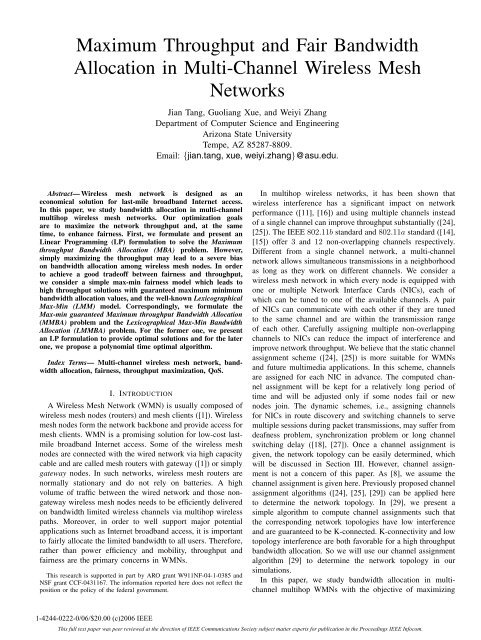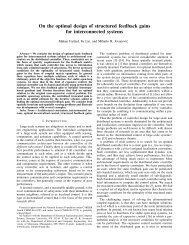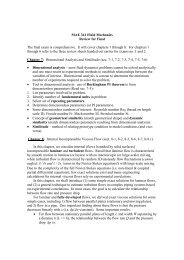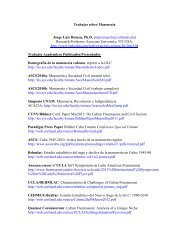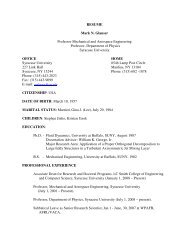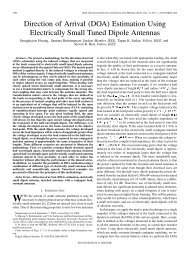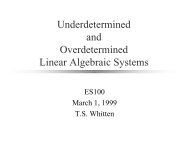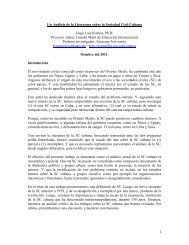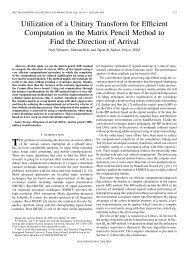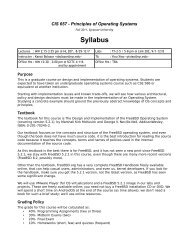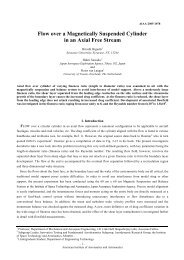Maximum Throughput and Fair Bandwidth Allocation in Multi ...
Maximum Throughput and Fair Bandwidth Allocation in Multi ...
Maximum Throughput and Fair Bandwidth Allocation in Multi ...
- No tags were found...
Create successful ePaper yourself
Turn your PDF publications into a flip-book with our unique Google optimized e-Paper software.
specifies the amount of flow routed through each wirelessl<strong>in</strong>k) to carry out the desired transmissions. We denote theaggregated flow on each l<strong>in</strong>k e by f e . What we really want tohave is a b<strong>and</strong>width allocation for every non-gateway node<strong>and</strong> a correspond<strong>in</strong>g flow rout<strong>in</strong>g solution (which specifiesthe route <strong>and</strong> the amount of flow allocated to each l<strong>in</strong>k onthe route for traffic between each non-gateway node <strong>and</strong> thewired network), not just the aggregated flow allocation vector.However, once we have the aggregated flow allocation vector,we can easily compute a correspond<strong>in</strong>g flow rout<strong>in</strong>g solution,which will be expla<strong>in</strong>ed <strong>in</strong> more detail <strong>in</strong> Section V. Wewish to emphasize that the b<strong>and</strong>width allocation is a noderelated concept, while the flow allocation is a l<strong>in</strong>k relatedconcept. In order to differentiate them, we will call the laterone aggregated l<strong>in</strong>k flow allocation <strong>and</strong> the correspond<strong>in</strong>gvector aggregated l<strong>in</strong>k flow allocation vector <strong>in</strong> the follow<strong>in</strong>g.Def<strong>in</strong>ition 1 (Feasible B<strong>and</strong>width <strong>Allocation</strong> Vector): Anaggregated l<strong>in</strong>k flow allocation vector f = [f 1 ,f 2 ,...,f m ]correspond<strong>in</strong>g to a given b<strong>and</strong>width allocation vectorb = [b 1 ,b 2 ,...,b N ] assigns an aggregated flow f e ≥ 0for each l<strong>in</strong>k e ∈ E such that at each non-gateway nodes i , the total flow out of 1 node s i m<strong>in</strong>us the total flow<strong>in</strong>to node s i is equal to b i . f is said to be a feasibleaggregated l<strong>in</strong>k flow allocation vector (correspond<strong>in</strong>g tob<strong>and</strong>width allocation vector b) if for every l<strong>in</strong>k e ∈ E, wehave A(e) = (C e − ∑ e ′ ∈IE ef e ′) ≥ 0, where C e is thecapacity of l<strong>in</strong>k e. We call A(e) the residual capacity onl<strong>in</strong>k e. A b<strong>and</strong>width allocation vector is said to be a feasibleb<strong>and</strong>width allocation vector if there exists a correspond<strong>in</strong>gfeasible aggregated l<strong>in</strong>k flow allocation.We note that the above method for residual capacity computationis a worst-case computation. Suppose that l<strong>in</strong>ks e 1 <strong>and</strong>e 2 are the l<strong>in</strong>ks <strong>in</strong>terfer<strong>in</strong>g with l<strong>in</strong>k e, but do not <strong>in</strong>terferewith each other. Then traffic on e 1 <strong>and</strong> e 2 may be transmittedsimultaneously accord<strong>in</strong>g to 802.11 DCF. In this case, morethan (C e − f e1 − f e2 ) traffic can be transmitted along l<strong>in</strong>ke. Therefore, A(e) is essentially a lower bound for the actualresidual capacity. However, this bound is tight because it isachievable <strong>in</strong> the worst case. We overestimate the <strong>in</strong>terferenceimpact <strong>and</strong> correspond<strong>in</strong>g b<strong>and</strong>width usage a little bit becausewe try to provide b<strong>and</strong>width guarantee for users <strong>in</strong> the WMN,which is very important for those multimedia applications.We try to propose a network layer (rout<strong>in</strong>g) solution <strong>and</strong>depend upon the 802.11 DCF for transmission schedul<strong>in</strong>g.If we allocate b<strong>and</strong>width <strong>and</strong> rout<strong>in</strong>g flows based on sucha computation, it is most likely that the b<strong>and</strong>width allocatedto each node <strong>in</strong> S is achievable even though the wirelesschannel is not reliable <strong>and</strong> 802.11 DCF is a r<strong>and</strong>om accessprotocol. Similar estimation methods have also been used byseveral previous QoS rout<strong>in</strong>g papers such as [29], [31]. S<strong>in</strong>ceneighbor<strong>in</strong>g nodes need to periodically exchange ma<strong>in</strong>tenancemessages, such as HELLO messages, a small amount ofb<strong>and</strong>width should be reserved for those rout<strong>in</strong>e traffic toprevent them from be<strong>in</strong>g destroyed by strong <strong>in</strong>terference.As a result, the l<strong>in</strong>k capacity C e <strong>in</strong> Def<strong>in</strong>ition 1 should beslightly smaller than the physical capacity of l<strong>in</strong>k e. Nowwe1 note our discussion <strong>in</strong> the second paragraph of this section.are ready to def<strong>in</strong>e the optimization problems to be studied.S<strong>in</strong>ce our ultimate goal is to maximize network throughput,we first formulate a problem which seeks b<strong>and</strong>width allocation<strong>and</strong> its correspond<strong>in</strong>g aggregated l<strong>in</strong>k flow allocation withmaximum throughput. Let the network topology G(V,E) <strong>and</strong>non-gateway node set S be given.Def<strong>in</strong>ition 2 (MBA Problem): The <strong>Maximum</strong> throughputB<strong>and</strong>width <strong>Allocation</strong> (MBA) problem seeks a feasibleb<strong>and</strong>width allocation vector for all nodes <strong>in</strong> S along with acorrespond<strong>in</strong>g feasible aggregated l<strong>in</strong>k flow allocation vectorsuch that the throughput of this b<strong>and</strong>width allocation vectoris maximum among all feasible b<strong>and</strong>width allocation vectors.As discussed before, simply maximiz<strong>in</strong>g the throughputmay starve some wireless mesh nodes. Therefore, <strong>in</strong> orderto achieve a good b<strong>and</strong>width allocation with regards to bothfairness <strong>and</strong> throughput, we formulate two fair b<strong>and</strong>widthallocation problems.Def<strong>in</strong>ition 3 (MMBA Problem): A feasible b<strong>and</strong>width allocationvector b is said to be a feasible max-m<strong>in</strong> guaranteedb<strong>and</strong>width allocation vector if for any other feasibleb<strong>and</strong>width allocation vector ˆb, we have m<strong>in</strong>{b i |i ∈{1, 2,...,N} ≥ m<strong>in</strong>{ˆb i |i ∈ {1, 2,...,N}. The Max-m<strong>in</strong>guaranteed <strong>Maximum</strong> throughput B<strong>and</strong>width <strong>Allocation</strong>(MMBA) problem seeks a feasible max-m<strong>in</strong> guaranteed b<strong>and</strong>widthallocation vector for all nodes <strong>in</strong> S along with acorrespond<strong>in</strong>g feasible aggregated l<strong>in</strong>k flow allocation vectorsuch that the throughput of this b<strong>and</strong>width allocation vector ismaximum among all feasible max-m<strong>in</strong> guaranteed b<strong>and</strong>widthallocation vectors.For a b<strong>and</strong>width allocation vector b =[b 1 ,b 2 ,...,b N ],wewill use r =[r 1 ,r 2 ,...,r N ] to denote the sorted version ofb such that r 1 ≤ r 2 ≤ ... ≤ r N . Similarly, for a b<strong>and</strong>widthallocation vectors ˆb, we will use ˆr to denote its sorted version.Def<strong>in</strong>ition 4 (LMMBA Problem): A feasible b<strong>and</strong>width allocationvector b is said to be a feasible lexicographicalmax-m<strong>in</strong> b<strong>and</strong>width allocation vector if for any otherfeasible b<strong>and</strong>width allocation vector ˆb, either r i = ˆr i fori =1, 2,...,N or there exists an <strong>in</strong>teger j ∈{1, 2,...,N}such that r i =ˆr i for i ˆr j .TheLexicographicalMax-M<strong>in</strong> B<strong>and</strong>width <strong>Allocation</strong> (LMMBA) problem seeksa feasible lexicographical max-m<strong>in</strong> b<strong>and</strong>width allocation vectorfor all nodes <strong>in</strong> S along with a correspond<strong>in</strong>g feasibleaggregated l<strong>in</strong>k flow allocation vector.The fairness model beh<strong>in</strong>d the MMBA problem is a simplemax-m<strong>in</strong> model. The b<strong>and</strong>width allocation vector obta<strong>in</strong>edby solv<strong>in</strong>g the MMBA problem is guaranteed to have themaximum m<strong>in</strong>imum b<strong>and</strong>width value, but is not necessarilya feasible LMM b<strong>and</strong>width allocation vector. The LMM is awell used fairness model ([12]) because it is believed to beable to provide a very good tradeoff between throughput <strong>and</strong>fairness.V. THE PROPOSED BANDWIDTH ALLOCATION SCHEMESIn this section, we present LP formulations for the MBA <strong>and</strong>MMBA problem, <strong>and</strong> an LP-based polynomial time optimal algorithmfor the LMMBA problem. First, we need to constructan auxiliary directed graph G ′ (V ′ ,E ′ ) accord<strong>in</strong>g to a givenThis full text paper was peer reviewed at the direction of IEEE Communications Society subject matter experts for publication <strong>in</strong> the Proceed<strong>in</strong>gs IEEE Infocom.
3network topology G(V,E). For each node v ∈ V , V ′ conta<strong>in</strong>sQ v nodes v λ1(v) ,v λ2(v) ,...,v λQv (v) , where λ 1 (v)
subject to∑f vw − ∑w≠v u≠v∑f uv =0;f vw − ∑w≠v u≠v∑f xy ≤ C uv ;(x,y)∈IE uvf uv = b v ; ∀v ∈ S ′∀v ∈ V ′ \{S ′ ⋃ {t}}∀(u, v) ∈ E ′ Of uv ≥ 0; ∀(u, v) ∈ E ′b v ≥ α; ∀v ∈ S ′By solv<strong>in</strong>g LP 2, we can obta<strong>in</strong> a maximum m<strong>in</strong>imumb<strong>and</strong>width value α, i.e., we can ensure that for any feasibleb<strong>and</strong>width allocation vector ˆb, we have m<strong>in</strong>{ˆb i |i =1, 2,...,N}≤α = m<strong>in</strong>{b i |i =1, 2,...,N}.Compared with LP 1, the objective of LP 3(α) is to maximizethe network throughput while mak<strong>in</strong>g sure that eachnon-gateway node v has a b<strong>and</strong>width allocation of at least α.Therefore, solv<strong>in</strong>g LP 2 to obta<strong>in</strong> α <strong>and</strong> then solv<strong>in</strong>g LP 3(α)can provide a max-m<strong>in</strong> guaranteed maximum throughputb<strong>and</strong>width allocation.It is more challeng<strong>in</strong>g to compute a feasible LMM b<strong>and</strong>widthallocation vector <strong>and</strong> its correspond<strong>in</strong>g feasible aggregatedflow allocation vector. We will present a polynomial timealgorithm for this problem by solv<strong>in</strong>g a sequence of LPs.Before proceed<strong>in</strong>g with the presentation of the algorithm,we prove an important property–the uniqueness of the feasiblelexicographical max-m<strong>in</strong> b<strong>and</strong>width allocation vector.Lemma 1: Let b 1 <strong>and</strong> b 2 be two feasible b<strong>and</strong>width allocationvectors which are both lexicographical max-m<strong>in</strong>. Thenb 1 j = b2 j for j =1, 2,...,N. In other words, the lexicographicalmax-m<strong>in</strong> b<strong>and</strong>width allocation vector is unique.PROOF. Let S1,S 1 2,...,S 1 K 1 be a partition of the set{1, 2,...,N} such thata. For any k ∈{1,...,K} <strong>and</strong> i, j ∈ Sk 1,wehaveb1 i = b1 j .b. For any 1 ≤ k
subject to∑f vw − ∑ f uv = α k−1 + δ k ;w≠v u≠v∑LP 5(k, ¯S,β)f vw − ∑w≠v u≠v∑f vw − ∑ f uv =0;w≠v u≠v∑f xy ≤ C uv ;(x,y)∈IE uvmaximize∀v ∈ S ′ \ ⋃ k−1j=0 S′ j (13)f uv = α j ; ∀v ∈ S j ′ , 1 ≤ j 0 (or f vu > 0), then there is a back edge(v, u) (or (u, v)) <strong>in</strong>G A ;iff uv =0<strong>and</strong> f vu =0, then thereis no edge between vertex u <strong>and</strong> v <strong>in</strong> G A .Clearly, dur<strong>in</strong>g the execution of the algorithm, for everynode v ∈ Sk ′ ,wemusthaveb v = α k . However, there maybe some node v ∉ ⋃ ki=1 S′ i such that b v = α k . Instead ofputt<strong>in</strong>g every node v with b v = α k <strong>in</strong>to ¯S, we use the residualgraph G A to decrease the card<strong>in</strong>ality of ¯S, i.e., reduce therunn<strong>in</strong>g time. However, we still need to solve LP 5(k, ¯S,β)to determ<strong>in</strong>e the actual Sk ′ .InLP 5(k, ¯S,β), β is a small <strong>and</strong>tunable parameter. The purpose of hav<strong>in</strong>g Constra<strong>in</strong>t (17) isto force more nodes out of ¯S <strong>in</strong> each iteration. In this way,we can decrease the runn<strong>in</strong>g time as well. Note that there isno Constra<strong>in</strong>t (14) when k =1.Algorithm 1 LMMBAStep 1 k := 1; α 0 := 0; S 0 ′ := ∅;Step 2 Solve LP 4(k); α k := α k−1 + δ k ;Step 3 Construct the residual graph G A (V ′ ,E A ) accord<strong>in</strong>gto the aggregated l<strong>in</strong>k flow allocation computed bysolv<strong>in</strong>g LP 4(k);¯S := ∅;forall v ∈ S ′ \ ⋃ k−1j=0 S′ jif there exists no path from v to t <strong>in</strong> G A¯S := ¯S ⋃ {v};endifendforallStep 4 Solve LP 5(k, ¯S,β); Y := ∅;forall (v ∈ ¯S such that β v > 0) doY := Y ⋃ {v};endforallStep 5 if (Y ≠ ∅)¯S := ¯S \ Y ; goto Step 4;elseSk ′ := ¯S;if ( ⋃ kj=0 S′ j = S′ )stop;elsek := k +1; goto Step 2;endifendifTheorem 1: Algorithm 1 correctly computes the feasibleunique lexicographical max-m<strong>in</strong> b<strong>and</strong>width allocation vectorb <strong>in</strong> polynomial time.PROOF. When we solve LP 4(1), we obta<strong>in</strong> the max-m<strong>in</strong>b<strong>and</strong>width allocation value α 1 , together with a b<strong>and</strong>widthallocation vector b such that α 1 = m<strong>in</strong>{b i |1 ≤ i ≤ N}.Note that i ∈ S 1 ′ implies b i = α 1 . However, b i = α 1does not imply i ∈ S 1. ′ So we construct the residual graphG A (V ′ ,E A ). If there is a path from v to t <strong>in</strong> G A , thenwe know that the b<strong>and</strong>width allocated to node v can be<strong>in</strong>creased (by a very small, but positive amount) to obta<strong>in</strong>another feasible b<strong>and</strong>width allocation vector while keep<strong>in</strong>g theb<strong>and</strong>width allocated to all other nodes unchanged. This meansthat v ∉ S 1. ′ However, when there is no path from v to t <strong>in</strong>G A , we cannot say for sure that v ∈ S 1.SowesetS ′ to<strong>in</strong>clude every such node v such that there is no path from vto t <strong>in</strong> G A . This means that S 1 ′ ⊆ S.In order to obta<strong>in</strong> S 1 ′ from S, wesolveLP 5(k, S,β), whichmaximizes the sum of the b<strong>and</strong>width values of the nodes <strong>in</strong>S, while keep<strong>in</strong>g the b<strong>and</strong>widths allocated to nodes not <strong>in</strong> Sat α 1 . Clearly, S is a proper superset of S 1 ′ if <strong>and</strong> only if thereexists a b<strong>and</strong>width allocation vector b so that<strong>and</strong>b i ≥ α 1 , 1 ≤ i ≤ N, (19)∑b i > |S|×α 1 . (20)i∈SThis full text paper was peer reviewed at the direction of IEEE Communications Society subject matter experts for publication <strong>in</strong> the Proceed<strong>in</strong>gs IEEE Infocom.
This means that when S ≠ S 1, ′ we can always identify atleast one node v ∈ S (β v > 0) such that v ∉ S 1 ′ <strong>and</strong> moveit out of S. Clearly,<strong>in</strong>atmostN −|S 1| ′ iterations, we willhave S = S 1. ′ This shows that we have computed S 1 ′ <strong>and</strong> theb<strong>and</strong>width value for S 1 ′ (α 1 ) correctly.For general k, 1
1210MBAMMBALMMBA400350300B<strong>and</strong>width864<strong>Throughput</strong>2502001501005020MBA MMBA LMMBA01 5 10 15 20 25 30Sorted Node IndexFig. 8. Network throughput (n =25,N =20,C =12,CAP =53.9)Fig. 5. B<strong>and</strong>width allocation (n =35,N =30,C =3,CAP =10.9)<strong>Throughput</strong>1101009080706050B<strong>and</strong>width5550454035302520MBAMMBALMMBA403020100MBA MMBA LMMBA1510501 5 10 15 20 25 30Sorted Node IndexFig. 6. Network throughput (n =35,N =30,C =3,CAP =10.9)Fig. 9. B<strong>and</strong>width allocation (n =35,N =30,C =12,CAP =53.9)55504540MBAMMBALMMBA500450400350B<strong>and</strong>width3530252015105<strong>Throughput</strong>300250200150100500MBA MMBA LMMBA01 5 10 15 20Sorted Node IndexFig. 10. Network throughput (n =35,N =30,C =12,CAP =53.9)Fig. 7. B<strong>and</strong>width allocation (n =25,N =20,C =12,CAP =53.9)That is to say, based on the MBA scheme, some of users willnot be able to access the network at all, which is def<strong>in</strong>itelynot desirable. Compared with the MBA scheme, the MMBAscheme improves the fairness somehow, without sacrific<strong>in</strong>gthe network throughput too much. It guarantees every nodebe allocated some reasonable amount of b<strong>and</strong>width. For thecases <strong>in</strong> which the network resources are relatively sparse(C = 3,CAP = 10.9), the throughput provided by theMMBA scheme is very close to the maximum throughput,which can be seen from Fig. 4 <strong>and</strong> 6. As expected, amongthe three b<strong>and</strong>width allocation schemes, the LMMBA schemeachieves fairest b<strong>and</strong>width allocation. If the b<strong>and</strong>width isallocated us<strong>in</strong>g the LMMBA scheme, we observe from theresults that the nodes are partitioned to several groups (usuallythe number of groups is very small) <strong>and</strong> with<strong>in</strong> each group,all nodes are allocate exactly the same amount of b<strong>and</strong>width.The throughput provided by the LMMBA scheme is alwayssmaller than that provided by the other two schemes, especiallyThis full text paper was peer reviewed at the direction of IEEE Communications Society subject matter experts for publication <strong>in</strong> the Proceed<strong>in</strong>gs IEEE Infocom.
for cases <strong>in</strong> which the network resources are relatively rich(C =12,CAP =53.9).VII. CONCLUSIONSIn this paper, we have studied b<strong>and</strong>width allocation <strong>in</strong> multichannelmultihop wireless mesh networks with the objective ofthroughput maximization <strong>and</strong> fairness enhancement. We haveformulated three b<strong>and</strong>width allocation problems, namely, the<strong>Maximum</strong> throughput B<strong>and</strong>width <strong>Allocation</strong> (MBA), theMaxm<strong>in</strong>guaranteed <strong>Maximum</strong> throughput B<strong>and</strong>width <strong>Allocation</strong>(MMBA) <strong>and</strong> the Lexicographical Max-M<strong>in</strong> B<strong>and</strong>width <strong>Allocation</strong>(LMMBA) problem. We have presented LP formulationsfor the MBA <strong>and</strong> MMBA problems <strong>and</strong> an LP-based polynomialtime algorithm to optimally solve the LMMBA problem.REFERENCES[1] I. F. Akyildiz, X. Wang, W. Wang, Wireless mesh networks: a survey,Elsevier Journal of Computer Networks, Vol. 47(4), 2005, pp. 445-487.[2] P. Bahl, R. Ch<strong>and</strong>ra, <strong>and</strong> J. Dunagan, SSCH: Slotted seeded channelhopp<strong>in</strong>g for capacity improvement <strong>in</strong> ieee 802.11 ad-hoc wirelessnetworks, Proceed<strong>in</strong>gs of ACM MobiCom’2004, pp. 216–230.[3] M.S. Bazaraa, J.J. Jarvis, H.D. Sherali, L<strong>in</strong>ear Programm<strong>in</strong>g <strong>and</strong> NetworkFlows (3rd edition), John Wiley & Sons, 2005.[4] D. P. Bertsekas, R. Gallager, Data Networks (2nd Edition), Prentice Hall,1991.[5] S. Boyd, L. V<strong>and</strong>enberghe, Convex Optimization, Cambridge UniversityPress, 2004.[6] M. Burkhart, P. von Rickenbach, R. Wattenhofer, A. Zoll<strong>in</strong>ger, Doestopology control reduce <strong>in</strong>terference, Proceed<strong>in</strong>gs of ACM Mobi-Hoc’2004, pp. 9–19.[7] R. Ch<strong>and</strong>ra, L. Qiu, K. Ja<strong>in</strong>, M. Mahdian, Optimiz<strong>in</strong>g the placement ofInternet TAPs <strong>in</strong> wireless neighborhood networks, Proceed<strong>in</strong>gs of IEEEICNP’2004, pp. 271–282.[8] R. Draves, J. Padhye, <strong>and</strong> B. Zill, Rout<strong>in</strong>g <strong>in</strong> multi-radio, multi-hopwireless mesh networks, Proceed<strong>in</strong>gs of ACM MobiCom’2004, pp. 114–128.[9] L.R. Ford <strong>and</strong> D.R. Fulkerson, Flows <strong>in</strong> Networks, Pr<strong>in</strong>ceton UniversityPress, 1962.[10] V. Gambiroza, B. Sadeghi, E. W. Knightly, End-to-end performance <strong>and</strong>fairness <strong>in</strong> multihop wireless backhaul networks, Proceed<strong>in</strong>gs of ACMMobiCom’2004, pp. 289–301.[11] P. Gupta, P. R. Kumar, The capacity of wireless networks, IEEETransactions on Information Theory, Vol. 46(2), 2000, pp. 388–404.[12] Y. T. Hou, Y. Shi, H. D. Sherali, Rate allocation <strong>in</strong> wireless sensornetworks with network lifetime requirement, Proceed<strong>in</strong>gs of ACM MobiHoc’2004,pp. 67–77.[13] X. L. Huang, B. Bensaou, On max-m<strong>in</strong> fairness <strong>and</strong> schedul<strong>in</strong>g <strong>in</strong>wireless ad hoc networks: Analytical framework <strong>and</strong> implementation,Proceed<strong>in</strong>gs of MobiHoc’2001, pp. 221–231.[14] IEEE 802.11 Work<strong>in</strong>g Group, Wireless LAN Medium Access Control(MAC) <strong>and</strong> Physical Layer (PHY) Specifications, 1997.[15] IEEE 802.11a Work<strong>in</strong>g Group, Wireless LAN Medium Access Control(MAC) <strong>and</strong> Physical Layer (PHY) Specifications - Amendment 1: HighspeedPhysical Layer <strong>in</strong> the 5 GHz b<strong>and</strong>, 1999.[16] K. Ja<strong>in</strong>, J. Padhye, V. Padmanabhan <strong>and</strong> L. Qiu, Impact on <strong>in</strong>terferenceon multihop wireless network performance, Proceed<strong>in</strong>gs of ACMMobiCom’2003, pp. 66–80.[17] J. M. Kle<strong>in</strong>berg, Y. Rabani, <strong>and</strong> E. Tardos, <strong>Fair</strong>ness <strong>in</strong> rout<strong>in</strong>g <strong>and</strong> loadbalanc<strong>in</strong>g, Proceed<strong>in</strong>gs of IEEE FOCS’1999, pp. 568–578.[18] P. Kyasanur, N. H. Vaidya, Rout<strong>in</strong>g <strong>and</strong> <strong>in</strong>terface assignment <strong>in</strong> multichannelmulti-<strong>in</strong>terface wireless networks, Proceed<strong>in</strong>gs of WCNC’2005,pp. 2051–2056.[19] H. Luo, S. Lu, A topology-<strong>in</strong>dependent fair queue<strong>in</strong>g model <strong>in</strong> ad hocwireless networks, Proceed<strong>in</strong>gs of IEEE ICNP’2000, pp. 325–335.[20] H. Luo, P. Medvedev, J. Cheng, S. Lu, A self-coord<strong>in</strong>at<strong>in</strong>g approachto distributed fair queue<strong>in</strong>g <strong>in</strong> ad hoc wireless networks,Proceed<strong>in</strong>gs ofIEEE INFOCOM’2001, pp. 1370–1379.[21] N. Megiddo, Optimal flows <strong>in</strong> networks with multiple sources <strong>and</strong> s<strong>in</strong>ks.Mathematical Programm<strong>in</strong>g, Vol. 7(3), 1974, pp. 97–107.[22] K. Moaven<strong>in</strong>ejad, X. Y. Li, Low-<strong>in</strong>terference topology control forwireless ad hoc networks, Journal of Ad Hoc <strong>and</strong> Sensor WirelessNetworks, Accepted for publication.[23] C. E. Perk<strong>in</strong>s, E. M. Royer, S. R. Das, Quality of service for ad hocon-dem<strong>and</strong> distance vector rout<strong>in</strong>g (work <strong>in</strong> progress), IETF InternetDraft, 2000.[24] A. Raniwala, T. Chiueh, Architecture <strong>and</strong> algorithms for an IEEE802.11-based multi-channel wireless mesh network, Proceed<strong>in</strong>gs ofIEEE INFOCOM’2005, pp. 2223–2234.[25] A. Raniwala, K. Gopalan, T. Chiueh, Centralized channel assignment<strong>and</strong> rout<strong>in</strong>g algorithms for multi-channel wireless mesh networks, ACMMobile Comput<strong>in</strong>g <strong>and</strong> Communications Review (MC2R), Vol. 8(2),2004, pp. 50–65.[26] J. So, N. H. Vaidya, <strong>Multi</strong>-channel MAC for ad hoc networks: H<strong>and</strong>l<strong>in</strong>gmulti-channel hidden term<strong>in</strong>als us<strong>in</strong>g a s<strong>in</strong>gle transceiver, Proceed<strong>in</strong>gsof ACM MobiHoc’2004, pp. 222–233.[27] J. So, N. H. Vaidya, Rout<strong>in</strong>g <strong>and</strong> channel assignment <strong>in</strong> multichannelmulti-hop wireless networks with s<strong>in</strong>gle network <strong>in</strong>terface,UIUC Technical Report, 2005. Available at: http://www.crhc.uiuc.edu/wireless/groupPubs.html[28] J. Tang, G. Xue, C. Ch<strong>and</strong>ler, W. Zhang, Interference-aware rout<strong>in</strong>g <strong>in</strong>multi-hop wireless networks us<strong>in</strong>g directional antennas, Proceed<strong>in</strong>gs ofIEEE INFOCOM’2005, pp. 751–760.[29] J. Tang, G. Xue, W. Zhang, Interference-aware topology control <strong>and</strong>QoS rout<strong>in</strong>g <strong>in</strong> multi-channel wireless mesh networks, Proceed<strong>in</strong>gs ofACM MobiHoc’2005, pp. 68–77.[30] L. Tassiulas, S. Sarkar, Maxm<strong>in</strong> fair schedul<strong>in</strong>g <strong>in</strong> wireless networks,Proceed<strong>in</strong>gs of IEEE INFOCOM’2002, pp. 763–772.[31] Q. Xue, A. Ganz, Ad hoc QoS on-dem<strong>and</strong> rout<strong>in</strong>g (AQOR) <strong>in</strong> mobilead hoc networks, Journal of Parallel Distributed Comput<strong>in</strong>g, Vol. 63(2),2003, pp. 154–165.[32] H. Zhai, J. Wang, Y. Fang, Distributed packet schedul<strong>in</strong>g for multihopflows <strong>in</strong> ad hoc networks, Proceed<strong>in</strong>gs of IEEE WCNC’2004, pp. 1081–1086.This full text paper was peer reviewed at the direction of IEEE Communications Society subject matter experts for publication <strong>in</strong> the Proceed<strong>in</strong>gs IEEE Infocom.


